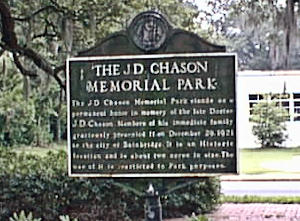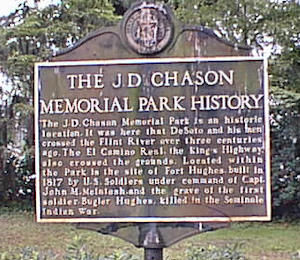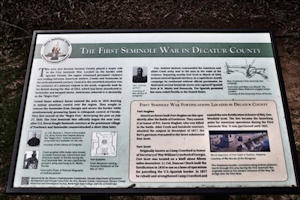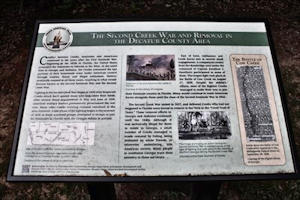Explore Southwest Georgia
Historical Markers in J. D. Chason Park
| There are 48 Historic Markers in Decatur County. Also see Historical Markers in | |
|
Historical Markers in Decatur County
|
Historical Markers in Bainbridge
|
Decatur County was once a frontier region shared by the Creek and the Seminole Nations. The Creeks, comprised of dozens of loosely associate groups, lived primarily along the southern reaches of the Chattahoochee and Flint Rivers in Alabama and Georgia. The closely-related Seminoles came together through similar alliances in Florida. Many of these people originally migrated to the region in the late 1700s and early 1800s to escape the pressures of American encroachment.
In the early 1800s, several Native American towns with historic ties to both the Creeks and Seminoles occupied this region. Prominent among these were the town of Pucknawhitla and Fowltown. Pucknawhitla stood within the city limits of what is now Bainbridge, while Fowltown, or Tutalosi Talofa in the Muskogee language, actually moved to multiple locations over a period of years. At the time of the First Seminole War (1817), it was located about four miles to the south. Other towns in the immediate area included Tamathli, Attapulgus, Wekiva, and Mikasuki.



Gaines sent another, larger force to Fowltown under the command of Lieutenant Colonel Matthew Arbuckle's men found the town abandoned upon their arrival. As they entered the village, though, Neamathla and a few dozen warriors suddenly emerged from hiding in the nearby woods. A pitched fight raged for about twenty minutes before the outnumbered warriors were forced to retreat. Seminole losses are believed to have been about ten killed, while American forces suffered only one killed and perhaps three wounded.
A week later, on November 30, 1817, a force of several hundred Creek and Seminole warriors in reprisal attacked a U.S. supply boat headed by Lt. Richard W. Scott. In what became known as the "Scott Massacre," nearly forty men and women were killed. Federal officials ordered General Andrew Jackson to the area in the aftermath.


United States military forces entered the area in 1816 desiring to extend American control over the region. They sought to remove the Seminoles from Georgia and secure the border while simultaneously pressuring Spain to relinquish control of Florida. They first moved on the "Negro Fort," destroying the post on July 27, 1816. The First Seminole War officially began the next year, after U.S. forces fought Seminole warriors at the prominent village of Fowltown and Seminoles counterattacked a short time later.
Gen. Andrew Jackson commanded the American and allied Creek army sent to the area in the wake of the violence. Departing nearby Fort Scott in March of 1818, Jackson entered Spanish territory. In a rapid three-month campaign he conducted without official permission, he destroyed several Seminole towns and captured Spanish forts at St. Marks and Pensacola. The Spanish protested but soon ceded Florida to the United States.
First Seminole War Fortifications Located in Decatur County

Fighting in the Second Creek War began in 1836 after desperate Creeks struck against those who had taken their lands. After several sharp engagements in May and June of 1836, American military leaders prematurely pronounced the war over. Many rebel Creeks resisting removal remained in the area, however. A new phase of the fighting began in the summer of 1836 as these scattered groups attempted to escape to join the Seminoles in Florida with the Georgia militia in pursuit.
East of here, militiamen and Creek forces met in several small engagements. A company of cavalry from the Bainbridge area under the command of Captain Jonathan C. Hawthorn participated in some of them. The largest fight took place at the Battle of Cow Creek on August 27, 1836. Despite the militia's efforts, most of the fugitive Creeks managed to make their way to join their Seminole cousins in Florida. Many would continue to resist American forces alongside them until the close of the Second Seminole War in 1842.
The Second Creek War ended in 1837, and defeated Creeks who had not migrated to Florida were forced to remove to the West in the "Creek Trail of Tears." These removal efforts in Georgia and Alabama continued until the 1840s. Although it was technically illegal for them to reside in Georgia, a small number of Creeks managed to evade removal by hiding, being sheltered by white friends, or otherwise assimilating into American society. Many people in southwest Georgia trace their ancestry to these survivors.
Also See
Historical Markers in Decatur County
Historical Markers in Downtown Bainbridge
Information from Latitude 34 North, GA Deptof Community Affairs and galileo.usg.edu
